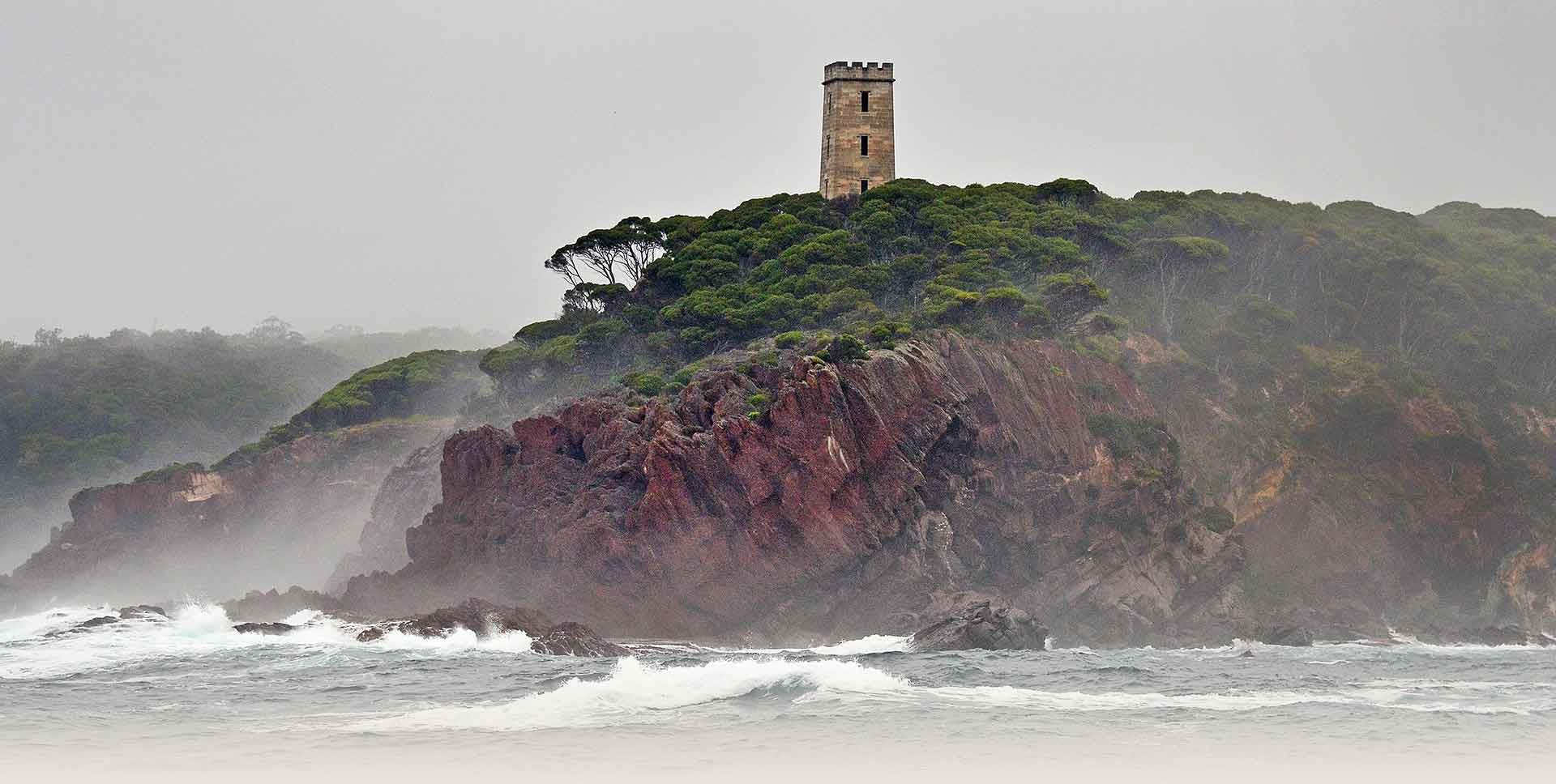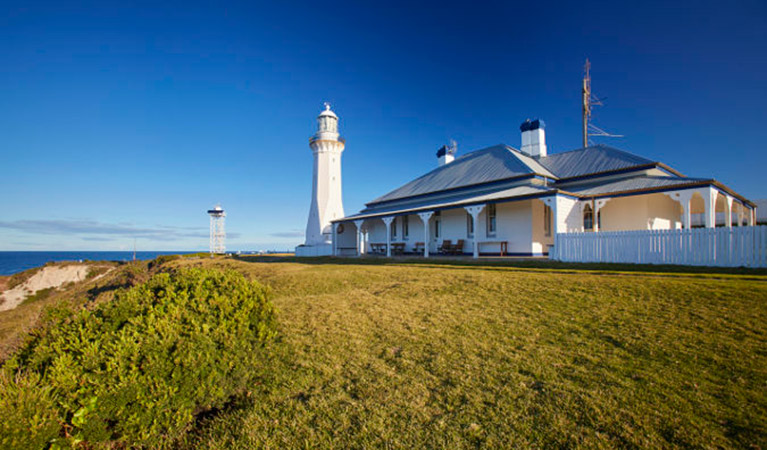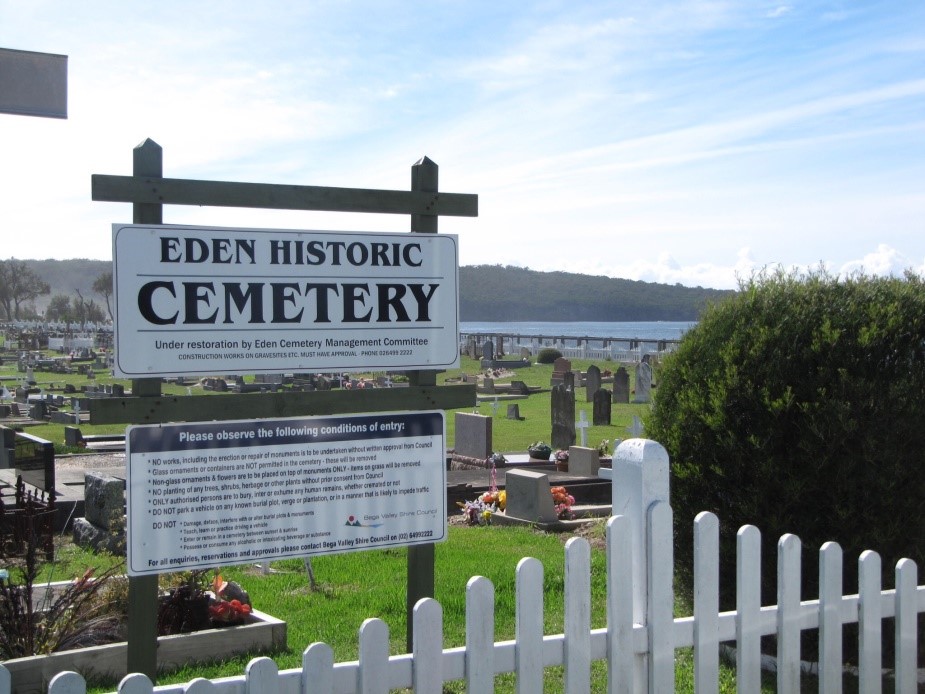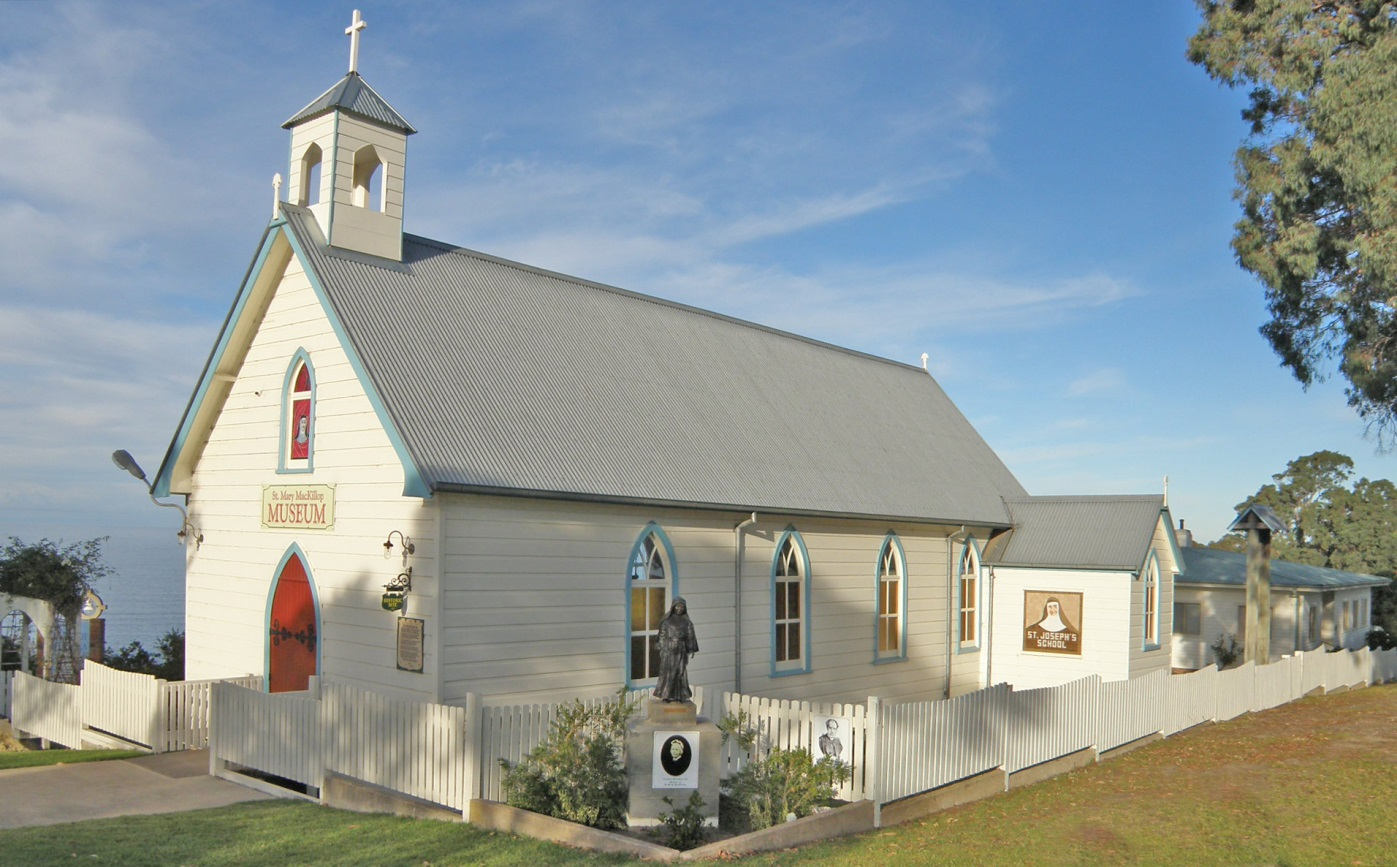Historic Sites and Buildings
By the end of 1861 Eden’s population declined to 265 permanent residents with a floating population of mariners. As was the way in most frontier towns of the era most of the population was housed in bark or slab huts as well as wattle and daub constructions. None of these survive today. A wooden lighthouse was constructed at Lookout Point in 1860 but can now only be seen in drawings.
The few more substantial buildings of stone or brick were mostly hotels. The ‘Eden Hotel’ (now the ‘Great Southern Hotel’) is the only survivor, built in 1847 as a combined hotel and grocery store. Many early buildings were of wooden construction and the bushfires that periodically ravaged the area destroyed a number of the more substantial stone buildings.
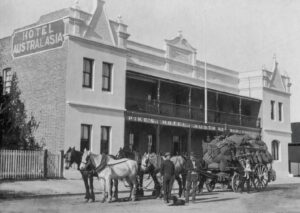 A landmark building in Imlay Street for more than a century, the Hotel Australasia was the last of Eden’s nearly two dozen hotels to be constructed & the most recent to close its doors.
A landmark building in Imlay Street for more than a century, the Hotel Australasia was the last of Eden’s nearly two dozen hotels to be constructed & the most recent to close its doors.
Mrs. Sabina Pike purchased the one acre allotment that would become the site of the hotel in late 1904, paying £500. This was reportedly the highest price paid for land in the township for a forty year period. In the wake of the purchase, local media reported on Mrs. Pikes intention to build “…a large up to date hotel…” on the block & by December 1904 she had awarded the construction contract to Mr. John Hines. With plans to erect a two-storey 43-room brick structure “…on up to date lines…” it is believed that the move was made in response to the expectation that Twofold Bay would become the site of Australia’s federal port.
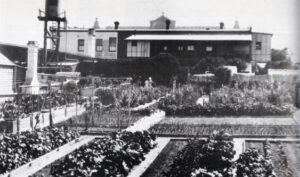
Finally opening its doors to guests in early January 1906 under publican Mr. W. A. Robertson, building owner & developer Sabina Pike had taken over the reins by the following month & was to remain as licensee of the Australasia for almost two decades. A divorcee with a wealth of experience in the hotel trade locally, “Aunty Pike” as she was fondly known, had previously operated Eden’s Commercial Hotel with her former husband James during the 1890s, before taking over as publican of the Great Southern Hotel for at least a decade. It was only when the Australasia was nearing completion that she relinquished that position & in January 1905, the license & goodwill was transferred to Sam Solomon. Writing of her business acumen, the Australian Town & Country noted that Mrs. Pike’s successful local business activities had led to her establishment of “…the splendid hotel…” where she managed the business personally & did “…everything possible for the comfort of her guests…” Describing the business in 1906, an journalist noted that the Australasia was “…the largest & most modern building in Eden…”, commenting that it was “…thoroughly up-to-date in all its appointments & is furnished most elaborately…”, which, combined with the “…magnificent views…” of ocean & harbour, made the premises “…an ideal place at which to stay…”
The hotel was closed in March 2012 and in April 2013 was sold to Artarmon-based retail development company Great Southern Developments Pty Ltd who proposed to build a supermarket, liquor store and retail tenancy on the site of the 110-year-old building. After protests from local residents the council passed a motion early in 2014 to include the building under Schedule 5 of the Comprehensive Local Environment Plan 2013 as a heritage item and rejected the development application.
In February 2016 to rousing applause from the Australasia Hotel community group, the council announced it would be negotiating to purchase the Eden hotel after a close 5-4 vote on the matter.
On Wednesday, BVSC voted to proceed with the option to purchase under the terms agreed with Southern Developments.In 2019 Councillors have voted to offload the Hotel Australasia in a debated vote on Wednesday.
Three years after purchasing the building, councillors yesterday agreed to sell the hotel although Crs Sharon Tapscott, Liz Seckold and Jo Dodds voted against the sale.
Eden Magnet
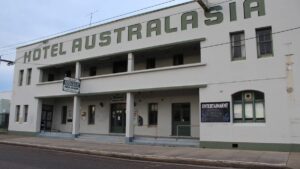 In 2019 the Hotel Australasia was sold to local builder Neil Rankin who is currently restoring the building.
In 2019 the Hotel Australasia was sold to local builder Neil Rankin who is currently restoring the building.
 The St George’s Uniting Church is probably one of the oldest continuously operating churches in Australia. It was opened on May 24 1866 by Rev. John Dunmore Lang on land bequeathed by George Barclay to the Presbyterian Church, whose congregations, formally known as St. Andrew’s Presbyterian Congregation had been meeting since 1859 in the Eden Court House. At the time it was built in 1865 St Georges was the first substantial place of worship in the district.
The St George’s Uniting Church is probably one of the oldest continuously operating churches in Australia. It was opened on May 24 1866 by Rev. John Dunmore Lang on land bequeathed by George Barclay to the Presbyterian Church, whose congregations, formally known as St. Andrew’s Presbyterian Congregation had been meeting since 1859 in the Eden Court House. At the time it was built in 1865 St Georges was the first substantial place of worship in the district.
The building was made of brick supported by buttresses on a stone foundation. The pulpit for the church was paid for by Alexander Davidson but at the time of its opening of the church it had no pews. In 1931 due to original brickwork beginning to crumble the exterior was rendered with cement and in 1961 the original roof was replaced. In 2007 the original bell tower was restored with the assistance of the local council Heritage Grant.
The Laying of the Foundation Stone
The Bega Gazette and County of Auckland Advertiser reported on the laying of the foundations for St Georges on the 27th May 1865:
‘A sealed bottle was placed in a cavity under the stone, containing the following, written on parchment; St. George’s Presbyterian Church, Eden, New South Wales; The foundation stone of this church was laid on May 24th 1865 by Mrs. Barclay, widow to the late George Barclay, Esq. who for many years was a steady and liberal supporter of Presbyterianism in the district. The site on which this church is built was given by Mrs. Barclay, in accordance with what she knew to be the wish of her late husband. It is intended that this church shall be placed under the superintendence of the Presbytery of Illawarra.
Those by whom this church has been created trust than no unchristian sound shall be heard within its walls, and that all the ministers who may be placed in it, shall freely and fearlessly proclaim the glorious gospel of Lord Jesus Christ. Glory be to the Father and to the son, and to the Holy Ghost.’
The Opening
The opening of the church was a major event for the town and people came from as far as fifty miles to attend.
The Bega Gazette and Eden District or Southern Coast Advertiser of 2 June 1866 reported on the opening of St George:
‘The labours of the day began at noon by service, at which the Rev. Dr Lang officiated, in fulfilment of a promise made some time since to the Rev. Mr. Boddie. The little church was comfortably crowded, even the aisle being occupied by cross seats. It is estimated that over 200 people gathered on the occasion. The service commenced with singing the 100th Psalm” At the end of the service the seven year old daughter of B. Russel Esq., was baptised and a collection made amounting to £13’ (according to the Rev. Lang’s account the amount raised was £32)
After a soiree or tea meeting was held in the church “the proceedings at which were very spirited, although in perfect accordance with the previous proceedings of the day”4 Early in the proceedings Joseph Teas stated that “the subscriptions received, added to the collections and anticipated proceeds of this meeting, would nearly, if not quite, enable him, as Treasurer, to state that they entered the building that day free of debt”. He went on to reassure the congratulation “that he trusted that in a very short time the church would be provided with suitable pews”.
In 1956 the Rev. W. Cummingthorn laid the foundation stone for a church hall. The hall was framed by contractor, Alby Latter and completed by local residents Jack and Doug Ireland. The hall was opened in 1958.
Current Projects
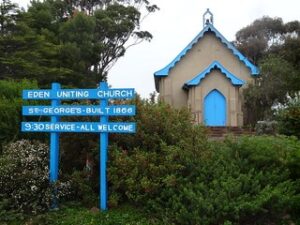 One of the church’s projects is the Garden of Eden Community Project. The objective of the Community Garden is to work with the community to create a eco-conscious and wonder-filled garden and a lively community art and cultural centre. There is a regular market in the church grounds; from 9am on, third Saturday of the month. A community pantry, open to all, operates Thursdays 10am to 1pm.
One of the church’s projects is the Garden of Eden Community Project. The objective of the Community Garden is to work with the community to create a eco-conscious and wonder-filled garden and a lively community art and cultural centre. There is a regular market in the church grounds; from 9am on, third Saturday of the month. A community pantry, open to all, operates Thursdays 10am to 1pm.
A Mission to Seafarers operates in Eden and welcoming activities are provided for the crews of large ships visiting the Port of Eden.
Construction of Boydtown began in 1843 when the newly arrived Scottish entrepreneur Benjamin Boyd proposed to base his Steamship Company at Twofold Bay. Boyd’s paddle-steamers operated between Sydney, Twofold Bay and Hobart.
Boyd purchased a large section of land in the southern portion of the Twofold Bay where he established the townships of Boydtown, which at its peak had 200 inhabitants and East Boyd where he established a whaling station. The first building erected in Boydtown was the Seahorse Inn, this was named after one of Boyd’s steam-boats. The foundations were constructed of sandstone imported from Sydney and the rest of the building from locally made bricks and hardwood and with cedar and oak fixtures imported from England. The hotel was built with convict labour and never fully finished. Boyd also built a row of houses, which he christened “Jerusalem,” for the use of the workmen he employed.
Boydtown’s church was thereafter constructed and roofed but never furnished due to the subsequent bankruptcy of Boyd in 1848.
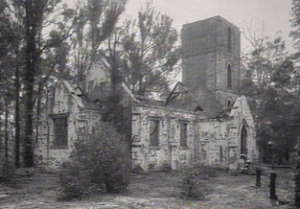 In 1883 a correspondent to the Australian Town and Country Journal reported…”In order to keep back as much as possible the development of the then young town of Eden, he [Boyd] bought allotments there, upon which no one was allowed to build. In spite of these precautions, however, Boydtown, with the exception of the hotel, which is now used as the private residence of Mr. Flavelle, the present owner of the property, is to-day in ruins and a town of the past.”
In 1883 a correspondent to the Australian Town and Country Journal reported…”In order to keep back as much as possible the development of the then young town of Eden, he [Boyd] bought allotments there, upon which no one was allowed to build. In spite of these precautions, however, Boydtown, with the exception of the hotel, which is now used as the private residence of Mr. Flavelle, the present owner of the property, is to-day in ruins and a town of the past.”
The Church lost its roof in 1926 in one of the many bushfires which have periodically devastated this area and which have also destroyed many other historic Boydtown buildings, but its crumbling walls still stand today on the hill behind the Seahorse Inn.
By 1936 due to neglect and vandalism the Seahorse Inn had been reduced a shell. It was in this year that it was purchased by a builder from Lakes Entrance, Mr R.B. Whiter who along with his two sons began the long task of restoring the inn and adding an extra storey.
Alan Whiter was sixteen when his father bought the Seahorse Inn and began its restoration with no electricity or running water. Alan and his brother Arthur mixed three thousand bags of cement by hand. Work on the site was interrupted by WWII when petrol rationing was introduced and the Whiter boys left Eden to serve in the military. After the war the family regrouped and restarted restoration of the inn, a task that was not finished until 1957.
Mr. Alan Whiter was interviewed as part of Eden Access Centre’s Oral History Project. Below is an excerpt from this interview.
‘There was a chimney standing on its own, about 50 yards to the east of the Seahorse Inn which is now gone and on the hill behind the remains of the old church, and wherever you went on the flat surrounding the Seahorse Inn was evidence of old buildings, all long gone and fallen down. It was from those buildings, which by now were laying on the ground in the bracken fern, we recovered all our bricks. All the raw materials were on site, so it was just a matter of putting it all together.
My dad had a connection in Melbourne with a lady called Mother Dally, that was her trade name, and she was a lady wrecker similar to ‘Whelan the Wrecker’ and from there he was able to get all his building material, like lead light windows and doors, all joinery with a period appropriate to that age, and they were all built in and most remain there to this day.
We finished the restoration in 1957…we decided to put it on the market. It was sold in 1957 and we then moved into Eden and continued in the building trade and that’s where we are today.’
 The building has changed hands a number of times since and underwent a four million dollar renovation which was completed in 2006 by the Lyon Group Australia which now run it as a picturesque, boutique hotel
The building has changed hands a number of times since and underwent a four million dollar renovation which was completed in 2006 by the Lyon Group Australia which now run it as a picturesque, boutique hotel
The Crown and Anchor Inn is the oldest standing and was the first substantial building in Eden. It was preceded by slab and bark huts only.
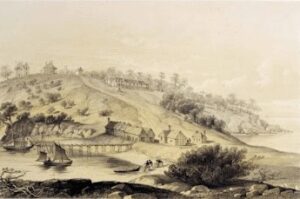
Originally a hotel, it was built in the mid-1840s by George Hirst. After Hirst went bankrupt and committed suicide the first license for the sale of ‘Fermented and Spirituous Liquors’ for the Crown & Anchor was issued to James Rixon in March 1845. Ben Boyd, in order to further his own interests at Boydtown, had travelled to Broulee ahead of Rixon where the Justice of the Peace was to grant the first liquor licenses for the area and prevailed upon the Justice not to grant Rixon a license. Rixon then had to make the arduous journey to Sydney obtain to his first license. In 1868 it was briefly used as the Telegraph Office. When the telegraph office was relocated next door to Half House the post master Charles Kebby and his wife Martha continued to live in the Crown and Anchor, renaming it ‘Sherwood Cottage’.
After the Kebbys died the house was extended to be used as a bank but the bank was never opened. The Kebby’s daughter, Alice and her husband Thomas Wellings moved in and renamed the Inn ‘Edgecliff’. They resided there until their deaths around 1935-1936.
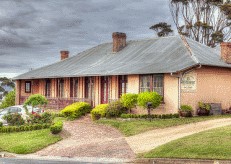 It now offers bed and breakfast accommodation and guests enjoy a commanding view of the bay, ocean and port.
It now offers bed and breakfast accommodation and guests enjoy a commanding view of the bay, ocean and port.
Eden Courthouse is listed on the Register of the National Estate. Dating from 1857, Eden Courthouse has a long association with the social history of Eden and district. Part of the importance of the courthouse is in its design that is quite different from 19th century New South Wales courthouse design. The building is asymmetrical with a flanking section to one side only, and it lacks the imposing formality of courthouses of the time.
Eden Court of Petty Sessions was established at Eden Courthouse in April 1847, the clerk of court being Mr Edward Ferris. Magistrates appointed that year included Mr (later Sir) Oswald Brierly. Mr William Walker and Mr James Walker. Eden police district in 1848 covered the county of Auckland. A chief constable and two constables were stationed at Eden. Mounted police were stationed at outposts. Eden watch house was established in 1849 with lookout point fenced off from the jetty area as a police paddock. Eden water police were formed in 1854.
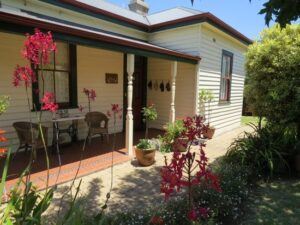 Behind the Court House in Cocora Street is Eden’s first Police Station and watch house built in 1850 following the stationing of police troopers here in 1848. The internal sandstone wall which formed part of the old cell block was built from sandstone that came to Eden as ballast in the old steamers. Now called Cocora Cottage it offers bed and breakfast accommodation.
Behind the Court House in Cocora Street is Eden’s first Police Station and watch house built in 1850 following the stationing of police troopers here in 1848. The internal sandstone wall which formed part of the old cell block was built from sandstone that came to Eden as ballast in the old steamers. Now called Cocora Cottage it offers bed and breakfast accommodation.
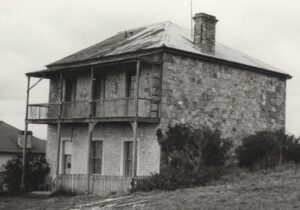 Next door to the Crown and Anchor Inn is the first two-story building erected in Eden, which has now been restored as a private residence. It was built in 1850 and was thus nick-named because its planned extension onto the gabled roof at one end was never completed. Like the ‘Crown and Anchor’ the original slate roof has been replaced by corrugated iron.
Next door to the Crown and Anchor Inn is the first two-story building erected in Eden, which has now been restored as a private residence. It was built in 1850 and was thus nick-named because its planned extension onto the gabled roof at one end was never completed. Like the ‘Crown and Anchor’ the original slate roof has been replaced by corrugated iron.
‘Half House’ was used as a Post Office until 1885 and was subsequently used as an office of the Government Savings Bank.
Before the erection of the Log Cabin the guides would rent Begaville House for their meetings. John Logan’s youngest daughter was an active member of the guides and the original site for the cabin was bought by Logan in 1935 from the Presbyterian Church and a scale model of a Log Cabin proposal was made to convince the Guides Association in Sydney of its merits. The model, made of dowel and wooden matchboxes, is still available for inspection at the Killer Whale Museum. The final cost of the building was 1500 pounds ($3000) with 500 pounds contributed by the Guides and the balance from John R Logan. Much of the erection of the building was achieved through working bees organised by Logan and the other guides parents.
The Opening Ceremony was held on February 29, 1936. Unfortunately, John Logan died in August 1937. The Eden Girl Guide activities ceased shortly after this time due to the prospect of World War II and lack of leaders.
Mrs Logan then sold Edrom Lodge, the family home since 1914, on the south side of Twofold Bay. She bought the Log Cabin from the Girl Guide Association, and lived there until shortly before her death in 1963. The property was then acquired by a succession of private owners who made a number of structural changes.
The Shire Council at the time (Imlay Shire) acquired the property in 1979 to house the Eden Town Library. The Library was relocated during December 2003, and the Eden Log Cabin Management Committee was appointed by the Bega Valley Shire Council in 2004 and commenced restoration of the building.
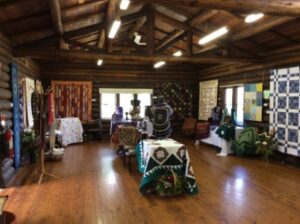 Since then much work has been done to bring the building back to its original state. Floors have been polished and facilities like the kitchen and toilet updated. The main room features a pebble fireplace.
Since then much work has been done to bring the building back to its original state. Floors have been polished and facilities like the kitchen and toilet updated. The main room features a pebble fireplace.
Today the cabin is available to rent. The main room features a wall hanging system which is ideal for art and craft displays and the Eden Spinners and the Eden Quilters Craft Groups both meet weekly in the cabin. There are enough table and chairs to seat thirty, with more available if needed.
Images of Eden’s Girl Guide Hall circa 1936 from the Wellings Collection at the National Library of Australia.
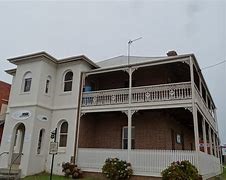 Construction of this building began late 1904 by John Hines for local general merchant TJ Ramsey.
Construction of this building began late 1904 by John Hines for local general merchant TJ Ramsey.
Ramsey had entered into an arrangement at the Bank’s request to provide the new building, which was then leased to the Bank of New South Wales. This arrangement continued until around 1954 upon the branch’s relocation to another specific built building on the corner of Bass and Imlay Streets, which saw it move several blocks closer to the main shopping area of the town.
Much like the Ramsey’s business, the building continued to be owned by the Ramsey family but tenanted out until around 1970 when it was purchased by well-known local commercial fisherman, Neil Buckland. Shortly after the purchase, the interior of the building changed significantly, being remodelled to accommodate two flat-styles living quarters on the top storey.
The balcony was wrecked in 1926 by a cyclonic wind burst from the disastrous bushfires that saw loss of housing around the Lookout area of Eden. Renovations of an unknown nature were undertaken in 1940. The building continues to be owned and lived in by the family of Mr Buckland.
A two storey brick and render building with a corrugated iron roof, the building originally had a high parapet with decorative urns concealing the roof behind. At some point the parapet was removed and the roof line extended to project beyond the wall.
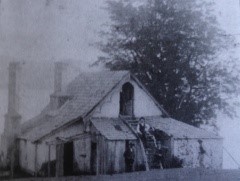
This remarkable home was owner-designed by John Logan. It is situated near the chip mill and enjoys commanding views across Twofold Bay towards Eden. In the 1840s the site of Edrom Lodge was the base for Benjamin Boyd’s activities at East Boyd and situated in what is now the front garden at Edrom was the home of Oswald Brierly, the talented artist and manager of Boyd’s whaling venture.
Building work on the Lodge commenced in 1910 and was completed in 1913 at a cost of £34,000. The 28-room manor was named for and modelled on Logan’s Scottish home. During its construction a small temporary settlement was established to house some of the 300 workmen employed on the project. A small sawmill and carpenter and blacksmith shops were built. Bricks, made locally at Fisheries Flat, and locally quarried granite were transported to the site using bullock teams.
Constructed of bricks with rock faced stone plinth and a terra cotta tiled multi gabled roof – the roof tiles were bought out to Australia from France as ships ballast – it is a fine example of Federation Arts and Crafts style architecture. The entrance hall, which has maple panelling with oak battens, opens into a large lounge hall, also with maple panels and oak battens, and a steeply pitched timber ceiling surmounted by roof lantern. Other features of Edrom include an impressive large timber inglenook in the lounge hall and the former dining room fully panelled in Tasmanian Blackwood with timber ceiling and fireplace with marble surround.
The family resided at the lodge until after John Logan’s death at Edrom in 1937. Edrom was purchased in 1947 by Roy Cross who hired Arthur and May Bate to act as caretakers and to run the business when Edrom opened as a Fishing Lodge in 1949.
The Bates bought a quarter share in the property and eventually a half share was sold to Roley and Jean Skellern who moved into one of Logan’s old workmen’s cottages at Honeysuckle Beach. After four years the Skellerns apparently tired of losing money and wishing to return to their former lives as farmers put their share on the market, an ad reading “swap half share in fishing lodge for a farm”.
Edrom was eventually sold to George and Daisy Rumpf who moved in 1958 and ran Edrom successfully for several years but eventually they subdivided the property. The twenty one acres on which Edrom stands was sold to Verne Horne who continued to run the Lodge as a guest house. Meanwhile, around 1966/67, the Harris Daishowa Company bought 130 acres on the shores of Twofold Bay next to Edrom for a wood chip mill which began operations in late 1969.
In 1970 Edrom was resumed by the State Government. In 1972 it was taken over by the NSW Department of Corrective Services as a pre-work release centre as part of its Work Release Programme or as the Daily Telegraph of February 10 1972 reported “Government resumed the property – in other words snatched it and took it over – as a site for Forestry Commission work. There was a certain amount of grumbling about the price and there still is but the fact remains that the Lodge in now owned by the Forestry Commission and now incredibly the Commission or the Department of Justice wants to make the place a prison farm.”
The Telegraph went on to deplore the prospect of “Twenty five convicts lolling about in Edrom Lodge enjoying the view that people used to pay for” and further despaired “Reason has flown. How sad, how bitter to despair finally of one’s fellow man in a place called Eden”.
In any event the facility was not open long closing its doors in 1975. A Report for the Department of Corrective Services for the year ended 30 June 1974 showed the lodge had dealt with only three prisoners for the 1972-73 period. In the 1973-74 periods it dealt with 52 with a daily average population of nine. On June 30 1974 the number of persons in detention at Edrom was reported as twenty.
 In 1980 Edrom Lodge was classified by the National Trust for its Federation period architecture and gardens. Today it is under long term lease and is available for conferences, educational and group activities.
In 1980 Edrom Lodge was classified by the National Trust for its Federation period architecture and gardens. Today it is under long term lease and is available for conferences, educational and group activities.
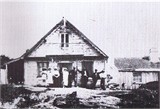 In 1857 Alexander Walker Davidson built a whaling station on the shores of Kiah Inlet about six kilometres south across Twofold Bay from Eden. Alexander built a substantial house “Kiah House” using timber from the wrecked ship ‘Laurence Frost’ which had been run ashore and abandoned nearby. Kiah House was burned down during bush fires in 1926.
In 1857 Alexander Walker Davidson built a whaling station on the shores of Kiah Inlet about six kilometres south across Twofold Bay from Eden. Alexander built a substantial house “Kiah House” using timber from the wrecked ship ‘Laurence Frost’ which had been run ashore and abandoned nearby. Kiah House was burned down during bush fires in 1926.
With equipment purchased from Benjamin Boyd’s earlier whaling business, Alexander established the most notable and longest running of the shore-based whaling enterprises of Twofold Bay, with 4 generations of his family continuing whaling until 1929. In 1930 the death of Old Tom the last of the famous pod of Killer Whales that had assisted the Davidson whalers bought to an end the Davidson whaling business and shore based whaling in Australia that “wild, exhilarating trade of the harpoon and lance”.
Alexander’s son, John, later leased all the land along the coast to Red Point and began using Boyd’s Tower as their whale spotting lookout.
The cottage, Loch Garrah which still stands at the station was built in 1896 by Alexander’ grandson, ‘Fearless’ George Davidson and lived in by the family until 1945 when they moved to Eden. An extension built from the old Green Cape post office was later added to Loch Garrah but dismantled in the 1930s and taken to Eden where it was used in the construction of the home of Mr. & Mrs. Severs, ‘Fearless’ George’s daughter and son-in-law.
Loch Garrah and the Try Works where whale blubber was boiled to extract the oil are open to the public and a viewing platform has been erected around the remains of the Try Works.
A host of artefacts, equipment and information about Eden’s whaling days can be seen at the Eden Killer Whale Museum, including the skeleton of “Old Tom’ whose body was recovered by George Davidson.
 The Davidson Whaling Station site is now administered by the NSW National Parks and Wildlife Service.
The Davidson Whaling Station site is now administered by the NSW National Parks and Wildlife Service.
An Old Lady Remembers: Published in Rene Davidson’s book ‘Whalemen of Twofold Bay’ and reproduced on Greg McKeen’s website, the often poignant reflections of Euphemia (Effie) Davidson, wife of John Samuel Davidson as told to her niece Debbie Nicholson in 1940 two days before Effie’s 100th birthday.
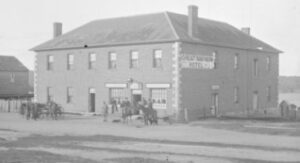
The balcony in the 1890s
National Library of Australia – C.E. Wellings collection
What is now the Great Southern Inn was built in 1857 as Barclay and Tea’s General Store which incorporated Eden’s first Post Office when George Barclay was appointed Post Master. In 1880 it was converted into a hotel and John Hopkins became the first publican.
It is one of only two survivors of a number of hotels built in the era when the Port of Eden was central to Benjamin Boyd’s and the Imlay Brothers’ large pastoral, whaling and business empires. The other is the Crown and Anchor further down Imlay Street toward the port, which now offers bed and breakfast accommodation.
The Kiandra Gold Rush (‘up Kosciusko way’) of 1859/60 brought an overnight boom to the port and township of Eden and its population swelled to around 4,000 as many fortune-seekers arrived and were equipped here. However, the boom was short-lived and by the end of 1861 Eden’s town population declined to 265 permanent residents with a floating population of sheltering mariners and these were mostly housed in bark or slab walled huts as well as wattle and daub constructions, as was the way in most frontier towns of the era. Of course, none of these survive today. The few more substantial buildings of stone, rubble or brick were mostly hotels.
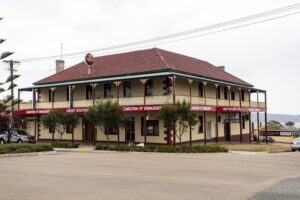 This hotel has been renovated and expanded since with a fine restaurant and substantial decking at the rear offering panoramic views across Twofold Bay.
This hotel has been renovated and expanded since with a fine restaurant and substantial decking at the rear offering panoramic views across Twofold Bay.
Built in 1847 this 23 metre tower constructed of blocks of Pyrmont sandstone imported from Sydney was initially intended as a lighthouse by Benjamin Boyd, the Scottish entrepreneur, who was then building Boydtown and East Boyd, and planned to base his Steamship Company in Twofold Bay. However, it was deemed unsuitable for the purpose by the Crown and was never commissioned.
Quite a number of such towers dotted the coast during the hey-day of Twofold Bay’s shore-based whaling operations, but the others were made of timber and have not withstood the ravages of bushfires which periodically sweep through this area. Boyd’s Tower itself was struck by lightning in the 1860s and as a result is missing a section from its top.
The tower was designed by Boyd’s Whaling Master, Oswald Brierly (who was also an artist, later knighted and appointed as Queen Victoria’s Marine Artist) and was situated just above the treacherous Seahorse Shoals whose presence is only detectable by breaking waves during heavy seas.
Following the collapse of Boyd’s financial empire, the tower was taken over by the Davidson family whose Whaling Station was based at Kiah Inlet. During the season the tower was manned daily to alert the Kiah Inlet crews to the presence of whales.
Carved into the ledge of the bottom north widow is a tribute to a popular young Norwegian man who had worked with the Davidson Family whalers. “In Memory of Peter Lia who was killed by a whale, September 28 1881; aged 22 years.”
In 1973 the area was declared a National Park and Boyd’s Tower was added to that Ben Boyd National Park in 1976. The site is now administered by the NSW National Parks and Wildlife Service.
FIRE AFFECTED AREA
Some areas of this park were affected by fire in 2019/2020. You’ll notice some changes to the landscape, as well as signs of recovery. Some areas may remain closed for longer to allow habitat to recover or because we’re repairing park infrastructure. Stay safe with these after-fire tips for visitors.
Built in 1883 and perched on the edge of a peninsula, Green Cape Lighthouse was once the tallest and is most southerly in NSW.
The light first shone from Green Cape Lighthouse on 1st November, 1883, and its oil-fired lantern could be seen 19 nautical miles out to sea as it flashed every minute on a revolving, clockwork mechanism. It is still, today, the second tallest lighthouse in NSW. The tower stands 29 metres from the base to the top of the lantern house and was the largest concrete structure in NSW at the time that it was built.
Excavation for the site had begun in 1881 after funds for its construction were initially allocated in 1879 and the site surveyed in 1880 as part of a plan by Francis Hixson to “light the coast like a street with lamps”.
It was also the first lighthouse built to an octagonal design on a square base, which made construction of the wooden formwork easier. Its design is remarkably similar to the earlier, timber-framed lighthouse situated on Lookout Point in Eden, which was the first lighthouse ever erected in the colony and was subsequently destroyed by fire.
The aggregate came from local sandstone cliffs, while the cement, sand and stores were landed at Bittangabee Bay to the north, and transported along a purpose-built, seven kilometre timber tramway. A telegraph station was also established so that Sydney could be alerted to the impending arrival of ships.
The original lighthouse needed a team of three lighthouse keepers to keep the beacon going. The keepers were on duty at all times and each would take a five hour shift overnight to keep watch and make sure the light never went out. Before electrification the keeper had to crank a handle and raise a set of iron weights up through the centre of the lighthouse every 45 minutes with each winding process taking five minutes or more. The weights would slowly descend again, keeping the light turning on its axis.
Each keeper was given a large stone cottage for himself and his family. The Head Keeper’s cottage consisted of six rooms with a detached kitchen and store. The semi-detached Assistant Keeper’s cottage consisted of four rooms with a detached kitchen and store. These quarters were described at the time as “commodious and comfortable”. After the original lighthouse was decommissioned in 1992 two of the cottages were converted into self-contained guest houses and the third is used by the caretaker.
In 1913 the speed of the flashes was increased by inserting a new mechanism and the original kerosene lamp was also altered and in 1926 the power and speed of the lamp were again increased. In 1962 the light was electrified and after two subsequent increases in power it was finally increased to 1 million candelas in 1967.
The lighthouse was automated in 1983 and has most recently been used as an automatic weather station for the Bureau of Meteorology.
In 1992 it was converted to a solar power and the old light was decommissioned in favour of a new steel framed latticework tower located further toward the point. The original lenses and mechanisms are still housed in the old tower.
The site itself is now managed by the NSW National Parks and Wildlife Service who conduct tours of the lighthouse site and tower 5 days per week, with a caretaker in attendance who also looks after security and cleaning.
Why not take a look at the beautiful Historic Cemetery situated overlooking Aslings Beach. The land has been used as a cemetery since the very early days when sailors would bring their dead to shore for burial. The oldest known burial was in 1834. The original cemetery location started just behind the sand hills where Aslings Beach Road now exists.
The Cemetery is the last resting place for many from our community and as you walk through you will find lots of familiar names from the early days of Eden and the surrounding district although the Cemetery was not officially dedicated until 16th June, 1863.
In later years the Eden Historic Cemetery Committee was formed and was responsible for the maintenance and beautification of the cemetery. The Lioness Club fundraising saw the first Niche Wall completed in November 1993. Pavers were laid and landscaping finished March 1994. Thanks to committee and community fundraising efforts a picket fence and a second niche wall were erected. The Eden Historic Cemetery Committee was awarded a Certificate for their efforts by the Bega Valley Council.
The Eden Cemetery was maintained and cared for by the Eden Historic Cemetery Committee, until the Bega Valley Shire Council took control in recent years. To search for memorials and grave sites in Eden Historic Cemetery click here.

In Eden itself the establishment of a new post office was announced by the General Post Office Sydney on 1 January 1847 the Post Master appointed being Mr Ferris.
Postmasters Barclay & Solomon 1849-1868
Postmasters Teas & Solomon 1849-1868
Mr George Barclay was registered as post master at Eden on 20 June 1849 with ‘plant and office’ located on the business premises of Joseph Teas. When Barclay died in December 1864 Tea’s application to succeed Barclay was rejected and Mr Solomon, Solomon was appointed post master. Solomon’s appointment caused some controversy. His application had been supported by the Bench of Magistrates (of which he was member) and a petition signed by a few local residents but after his appointment there was community outcry and a petition for his removal was submitted along with the nomination of Mr Barclay’s widow for post mistress. The petition seems to have failed as Solomon was listed amongst the postmasters and licensed vendors of stamps in the Sydney Morning Herald on the 2nd January 1866.
The Kebby’s Years 1868-1907 – The age of the ‘Telegraph
In 1868 Mr Charles Kebby was appointed Eden Post & Telegraph Station Master & line repairer. Mr Kebby lived in ‘Half House’, which was also used as the Post Office. The telegraph office was at first temporarily located in the Exchange Hotel but moved shortly after to the ‘Crown and Anchor’ next to the post office. The telegraph line between Twofold Bay and Bombala via Tantawangalo Mountain was completed in the same year by contractor, Mr. Thomas Fitzpatrick. Also opened later the same year were telegraph lines between Eden and Merimbula and Eden and Bega.
The New (Old) Post Office 1901-1971 and the coming of the Telephone
From 1885 the post office was relocated to premises rented from Thomas Rawlinson at 237 Imlay Street but the building was in a dilapidated state and it was reported that when the wind blew, the building shook. A tender for the erection of new post office on the corner of Imlay and Mitchell Streets was accepted by the Public Works Department on May 28 1888. The contractor named as George Hodgson with S.W. Aspinall as manager. Work on the building was expected to be finished by November but ‘continued dry weather’ meant the contractor was not able to continue brick making ‘for want of water’ and had to purchase bricks. In 1889 the postmaster had to extend the lease of the old post office and it was not until December 1900 that Postmaster Mr Kebby was able to inform Sydney that only the fencing remained outstanding. On the 1st January 1901 the new Eden Post Office opened on the corner of Imlay & Mitchell streets . In 1889 approval had been given for the provision of an additional bedroom and a bathroom but these additions were not completed until around 1902.

After Post-master Mr Kebby’s transfer to Sydney in 1907 his post was held by a succession of temporary replacements. On September 4 1907 Mr. H. Litchfield, previously the postmaster at Robinson, was appointed postmaster at Eden. He held the post until his death in 1915 aged 61.
Over the years the old Eden Post office saw several modifications notably in 1909 when Eden entered a new era.
The first telephone exchanges in Australia were opened in Melbourne and Sydney in 1880 and by 1901, when the six Australian States federated, there were 32,767 telephones in use. Until then each state had built its own telephone services but in 1905 the new parliament of Australia passed the Wireless Telegraphy Act giving control of all wireless to the Postmaster General’s department. In 1907 the Sydney-Melbourne trunk telephone line opened and on April 14 1909 a new telephone exchange was opened in the Eden Post Office. The telephone exchange was located in the post office lobby attached to the office. The first subscribers to the new telephone service were:
A decline in telegraph traffic saw the final telegram transmission to Bombala in 1966.

In 1949 a local paper reported that there was an increase in demand for postal services due to an increase in population in the district because of the establishment of the chip mill at East Boyd. Consequently the working conditions at the post office were cramped and in peak times the public areas of the post office were congested. A new post office site was gazetted in June 1949 on the site on which the present post office is sited but it was not until July 1971 that the new post office was opened and another year before the telephone exchange was moved to the new location. The new exchange was automated and the ladies who had formally operated the exchange were made redundant.
The old Post Office building was then rented by the Imlay Shire council for use by the Imlay Emergency Services and later for the library. It was subsequently used for other organisations.
Sources:
Historic Places Survey, Eden New South Wales – Compiled Eden Killer Whale Museum and Historical Society assisted by funds allocated to the Royal Australian Historical Society through the Heritage Office [NSW] 2010 – Available for viewing at Eden Library
Wikipedia
History of telegraphy in Australia
The History of Communication Technology ‘Telegraph’
www.australia.gov.au
‘The Overland Telegraph’
Vintage Phones ‘History of Telephone Exchanges in Australia’
Telstra website – Telecommunications Timeline 1890-1919
 Australians now have their own saint – a woman recognised as being holy and a great pioneer for the Catholic Church. Mother Mary was born in 1842 and founded the Catholic order of the Sisters of St Joseph after setting up a school in Penola, South Australia, in 1866. She spent her life educating and caring for people from all walks of life. She maintained her faith and dedication to helping people, despite a backlash from church leaders and suffering ill health for many years up until her death in Sydney in 1909.
Australians now have their own saint – a woman recognised as being holy and a great pioneer for the Catholic Church. Mother Mary was born in 1842 and founded the Catholic order of the Sisters of St Joseph after setting up a school in Penola, South Australia, in 1866. She spent her life educating and caring for people from all walks of life. She maintained her faith and dedication to helping people, despite a backlash from church leaders and suffering ill health for many years up until her death in Sydney in 1909.
Mary Mackillop’s link with Eden came about when her mother, Flora, drowned at sea in the Ly-ee Moon in 1886, near Green Cape. Mary’s mother, Flora was on her way to Sydney in May 1886 to assist Mary with the Caledonian stall, raising funds for the Providence Home for the destitute and infirm, when the steamer ship, Ly-ee Moon, struck a reef, breaking into pieces and drowning 71 passengers and crew, with only 15 people surviving.
Almost miraculously Flora’s body was recovered days later, unmarked from the sea, wearing only the religious scapular around her neck. Mary was so touched by the compassion of Eden’s residents who cared and prepared her mother’s lifeless body, that within five years of the tragedy she sent three of her Religious Sisters to start and staff St Joseph’s School, Eden in 1891.
Mary’s life and work had many important emotional and historical ties to the Bega Valley area. The citizens of Eden have preserved their close association to this pioneering and saintly woman by naming a street near the convent, Flora Street, after Mary’s mother. Parishioners also restored the old 1860 Star of the Sea Catholic Church, renaming it Mary MacKillop Hall.
Mary Mackillop Hall is part of Our Lady Star of the Sea Catholic Church, and is located on Calle Calle Street overlooking Twofold Bay in Eden.
